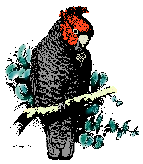 |
canberrabirds
|
 |
canberrabirds
|
| To: | <>, <> |
|---|---|
| Subject: | More Satin Bower Birds in Higgins |
| From: | "Philip Veerman" <> |
| Date: | Thu, 20 Oct 2011 15:05:08 +1100 |
|
In the
absence of any further information, the answer to the conundrum is definitely
one. That has always been the case since the GBS started and is quite clear on
each version of the GBS Chart instructions. The reason being: if it is the
situation that your area can (or does) only support one bird of that species at
one time, and thus there is a reason why you only see one at a time, then it
would be wrong to report two. The situation Anthony described for the Satin
Bowerbirds at his place at this point in time is probably such a case. Another
reason is that we would end up with higher average numbers of sexually / age etc
dimorphic species than those in which it is harder to distinguish individuals.
The two groups of species would be counted differently. The first group would
get more twos and the second group more ones. In some species we would add the
number present at two times and other species we would not, simply because the
observer would not know it is another individual. That would create a big
and ridiculous bias in the GBS results. Also adding numbers present at one time
to numbers present at another time (regardless of that we know they are
different birds) can lead to absurd results, entirely biased by the number of
times a person goes counting, such as shown in some of the Yellow-faced
Honeyeater counts.
However that is just based on one observation. When considering
other birds, especially very social species such as (sexually dimorphic and easy
to know they are different birds) like Magpie-larks and King Parrots, if you
look for a few more minutes or on another day, or listen to them calling to each
other even if you only see one, then you probably will find that at some other
time within the same week you will have both or more present simultaneously.
Then the answer to the question is look again and then the answer will
likely be two or whatever. In many observations that will be the real
situation. If that doesn't change things, then the answer is still one.
If you
regularly see a male and a female many times in the one week, especially on
overlapping times but not at the same time, then you should think what are the
chances that they are not both simultaneously present within that 3 + hectare
area at any time during the week. Pretty small. Indeed it may indicate that they
are nesting and one or other is hidden on a nest somewhere. (That does not apply
to Satin Bowerbirds). Common sense would indicate that the answer then would be
2.
In
terms of contributing to the GBS, the biggest wrong answer to the question is "I
don't know how many there are so I won't enter any number". That is the same as
an entry of zero.
Philip
-----Original Message----- Hi Paul and othersFrom: Anthony Overs [ Sent: Thursday, 20 October 2011 12:07 PM To: Paul T. Cc: Subject: Re: [canberrabirds] More Satin Bower Birds in Higgins Since moving to Mataranka St in Hawker in January I've seen a green Satin Bowerbird once every couple of weeks or so, sometimes every week for a month (trying to remember what's on my GBS chart...). In the past few weeks I've had a blue/black bird visit on several occasions. He has also been seen by friends further down the street. Haven't seen him for a week or so. He could be at your place! It has raised a GBS conundrum again. The maximum number of Satin Bowerbirds I've seen in any one week at any one time is one, despite the fact that I saw a green bird and a blue bird in the same week (at different times). What is the total number I put on the chart? Cheers Anthony On 20 October 2011 11:56, Paul T. <>
wrote:
Howdy All, |
| <Prev in Thread] | Current Thread | [Next in Thread> |
|---|---|---|
| ||
| Previous by Date: | More Satin Bower Birds in Higgins, Mark Clayton |
|---|---|
| Next by Date: | Painted button Quail, Williams, Roger |
| Previous by Thread: | More Satin Bower Birds in Higgins, Mark Clayton |
| Next by Thread: | More Satin Bower Birds in Higgins, martin butterfield |
| Indexes: | [Date] [Thread] [Top] [All Lists] |
The University of NSW School of Computer and Engineering takes no responsibility for the contents of this archive. It is purely a compilation of material sent by many people to the Canberra Ornithologists Group mailing list. It has not been checked for accuracy nor its content verified in any way. If you wish to get material removed from the archive or have other queries about the list contact David McDonald, list manager, phone (02) 6231 8904 or email . If you can not contact David McDonald e-mail Andrew Taylor at this address: andrewt@cse.unsw.EDU.AU